Disclosure: This post may contain affiliate links. I may earn a small commission for my endorsement, recommendation, testimonial, and/or link to any products or services from this website.
Let’s learn how to make pizza dough at home! Believe it or not, with this easy pizza dough recipe and step-by-step instructions, you can create restaurant-quality pies whenever the craving strikes. Your family will love the tender and soft crust that’s crisp and chewy on the outside, but fluffy and tender on the inside. Load on all of your favorite toppings!
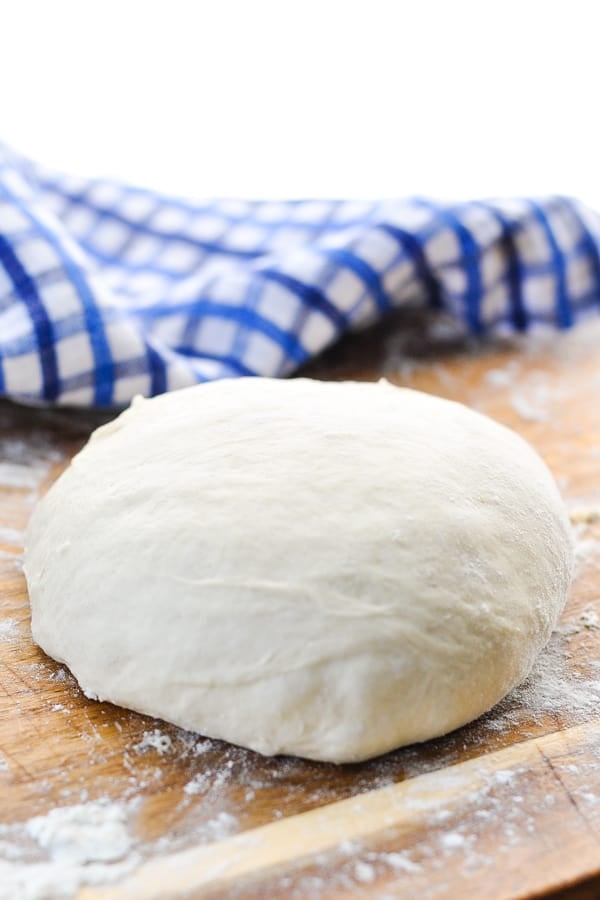
How to Make Pizza Dough at Home
First, let’s be clear: there’s absolutely nothing wrong with ordering takeout pizza or baking a store-bought frozen pizza in the oven when you need something fast. On other occasions, however, if there’s a little bit more time in the schedule — you can turn to this easy pizza dough for a truly gourmet meal. I’ve experimented with a variety of recipes over the years, and eventually landed on the simple process that I’ll share with you below. The recipe is adapted from America’s Test Kitchen, and it is definitely the best homemade pizza dough! You’ll feel like you’re dining in a cozy little pizzeria in Italy…from the comfort of your own home.

Easy Pizza Dough
There’s truly nothing difficult about this process, so don’t be intimidated by the yeast! Sure, there might be some even quicker dough recipes out there that don’t require a rising time, but I find that a little bit of extra patience pays off big time. The hardest part is waiting! Otherwise, this easy pizza dough comes together with just a few simple steps: mixing, kneading and resting.
Ingredients for Homemade Pizza Dough
- Bread flour
- Instant (“rapid rise”) yeast
- Salt
- Olive oil
- Warm water
How to make Pizza Dough Step-by-Step
Once your ingredients are assembled, you’re ready to get started. Just remember to allow at least 1 ½ hours of total resting time, so prepare that dough in advance!
Step 1: Combine Dry Ingredients
In a large bowl, whisk together the flour, yeast and salt.
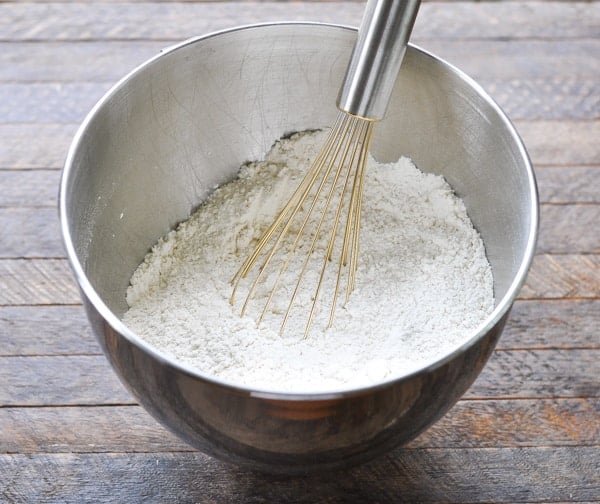
Step 2: Add Wet Ingredients
Gradually add the oil and warm water. The dough should come together in a rough ball and pull away from the sides of the bowl. If it’s too sticky and wet, gradually add a little bit more flour.
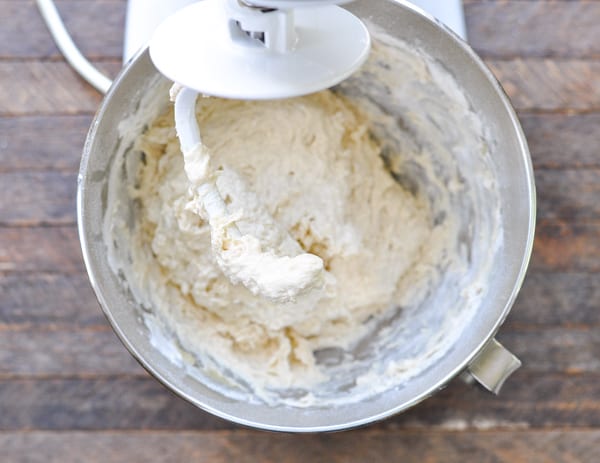
Step 3: Knead the Dough
If you have a stand mixer, use the dough hook to knead the dough for 5 minutes. You can also knead the dough by hand, if you prefer.
Step 4: Proof
Transfer the dough to a greased bowl, turn the dough to coat with oil, and then cover with plastic wrap.
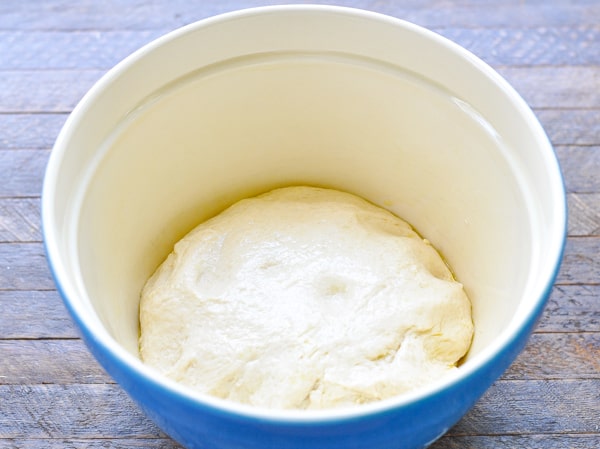
Let the dough rise in a warm place until it is doubled in size, about 1 – 1½ hours.
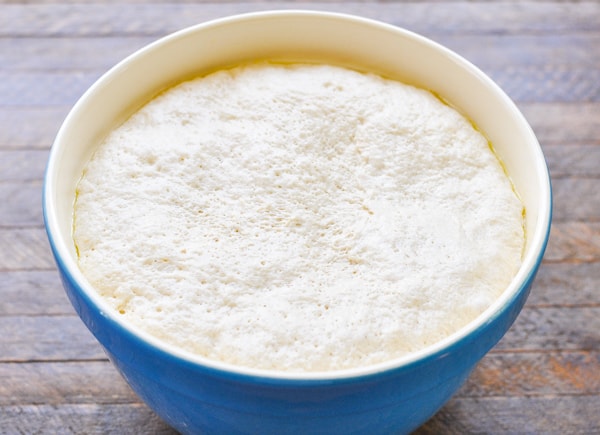
Step 5: Divide Dough
Turn the dough onto a lightly floured surface. Cut it into three equal pieces and cover with plastic wrap. Shape each piece of dough into a smooth, round ball. Cover with plastic wrap again and let the dough rest for about 20-30 minutes while you preheat the oven and prepare your toppings.
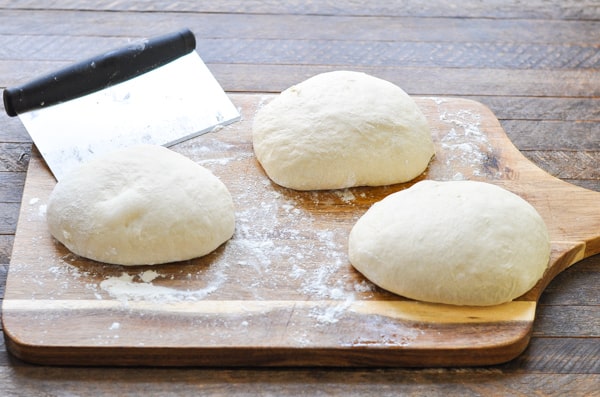
Step 6: Roll the Dough
Uncover the dough and stretch and shape the dough into a 12-inch round on a piece of parchment paper. You can use a rolling pin for this step, but I find it easier to just stretch and pull and press with my hands. Slide the parchment paper and dough onto a baking sheet.
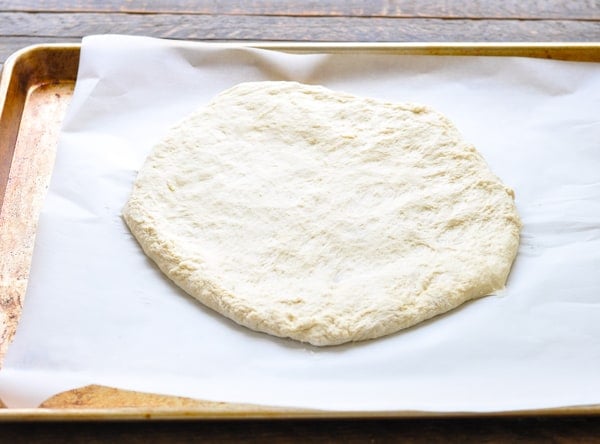
Step 7: Add Toppings
Add your desired toppings, and then brush the crust with olive oil.
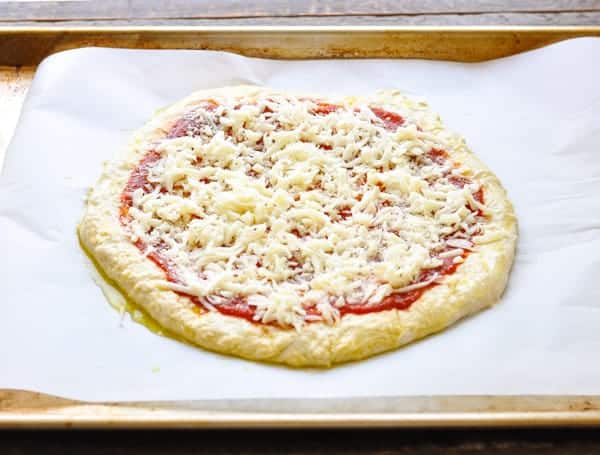
Step 8: Bake
Bake the pizzas at 475 degrees F for 14-17 minutes, or until the crust is golden brown and the cheese is melted. Slice into triangles and serve!

What’s the Best Stand Mixer for Pizza Dough?
If you’re shopping for a stand mixer for pizza dough, check out this list of the best mixers for bread dough, which includes the one I use, the Kitchenaid 5-quart Artisan Series stand mixer. You can get it on Amazon for $379.99. Or, the Hamilton Beach 4-quart stand mixer is a good budget option that’s available at Walmart for $98.99.
How to Knead Pizza Dough By Hand
If you don’t have a stand mixer, no problem! Simply add the oil and water to the flour mixture and stir with a rubber spatula until the dough comes together.
Kneading the dough makes the pizza crust light, airy and chewy by developing the gluten. Strengthening the gluten strands gives your dough structure. Don’t worry — kneading by hand is really easy! To knead the dough, flour the worktop, and then push, pull and stretch the dough. When it’s properly kneaded, the dough should be elastic and smooth. This will take about 10 minutes.
How to Proof the Easy Pizza Dough
Proofing homemade pizza dough is when you give the yeast time to do its work to help the dough rise. To proof the dough, place in a greased bowl and let the dough rest in a warm, humid environment until it doubles in size.
If you’re having trouble proofing the dough, check the temperature of your kitchen. If your kitchen is a little too cool (below about 65 degrees F), it may affect the proofing stage because the yeast doesn’t have a chance to become active enough to create gas to lift the dough. You should try letting it sit out a little longer, or find a warmer spot.
Can pizza dough rise too much?
Yes! You can over-proof the dough if you leave it out to rise for too long. In this case, the yeast gets too active and produces so much gas that the dough effectively pops like a balloon. This may deflate the dough as you prepare your pizza, resulting in a flat and dense pie.
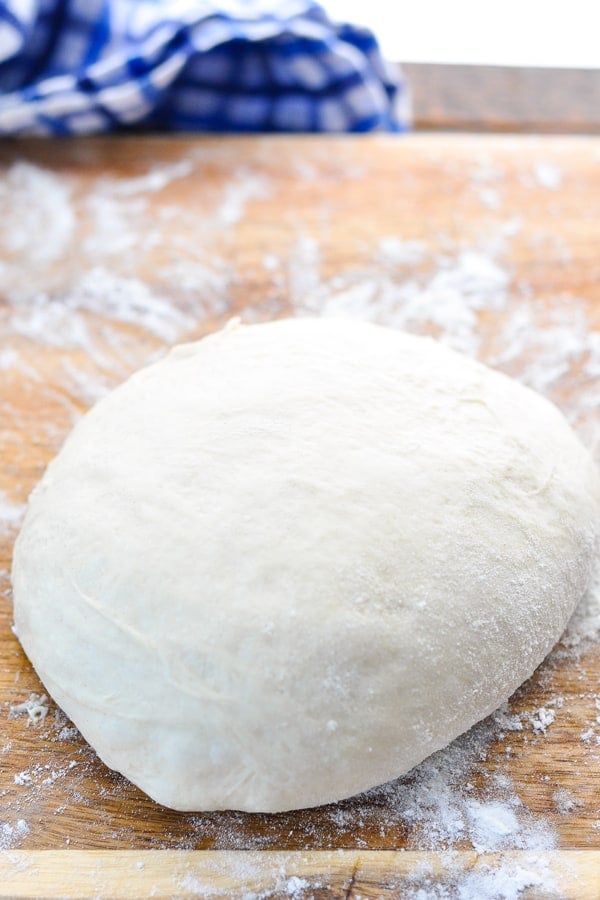
What’s the best flour for pizza dough?
All-purpose flour has between 8 and 11 percent protein, while bread flour contains between 12 and 14 percent protein. I recommend bread flour for this easy homemade pizza dough because the extra protein in bread flour yields a chewier crust. You can substitute with an equal amount of all-purpose flour for a softer crust.
Instant Yeast vs. Dry Active Yeast
This recipe calls for instant (or “rapid-rise”) yeast, which you can add directly to your dough. By contrast, active dry yeast must be dissolved in warm water (“proofed”) before combining with other ingredients. If you prefer to use dry active yeast, you can find helpful instructions for making that substitution in this article from Cook’s Illustrated.
Make Ahead
After transferring the dough to an oiled bowl, cover tightly with plastic wrap and refrigerate for up to 16 hours. Let the dough sit at room temperature for 30 minutes before dividing and shaping into pieces, as instructed. Proceed with the recipe from there!
Can pizza dough be frozen?
Yes! This is a great way to prep ahead and always have homemade pizza ready to assemble. If you only need a small pizza dough recipe to serve one or two people, you can freeze the extra dough balls for later, too.
To freeze the dough, let it rise fully, divide into 3 separate balls (as instructed in the recipe), and then lightly coat each ball of dough with olive oil. Place each dough ball in a separate Ziploc freezer bag, squeeze out all of the air, and store in the freezer for up to 3 months.
When ready to use, put the bag of dough in the fridge to thaw overnight. Before making the pizza, bring the dough to room temperature for at least 30 minutes before stretching and shaping the pizza.
Pizza Toppings
Add any toppings that your family loves. We keep it simple with just pizza sauce, mozzarella cheese, and Parmesan cheese, plus the occasional pepperoni pie. Garnish with fresh basil just before serving!
- You can also top the pizza with sautéed sliced mushrooms, onion, bell pepper and olives for a veggie-packed meal.
- Hawaiian Pizza: Top the pizza with sauce and cheese, and then add diced ham and/or cooked bacon and diced pineapple.
- BBQ Chicken Pizza: Use barbecue sauce instead of the marinara sauce and cheddar cheese instead of the Parmesan. Add grilled or rotisserie chicken, sliced red onion and bacon.
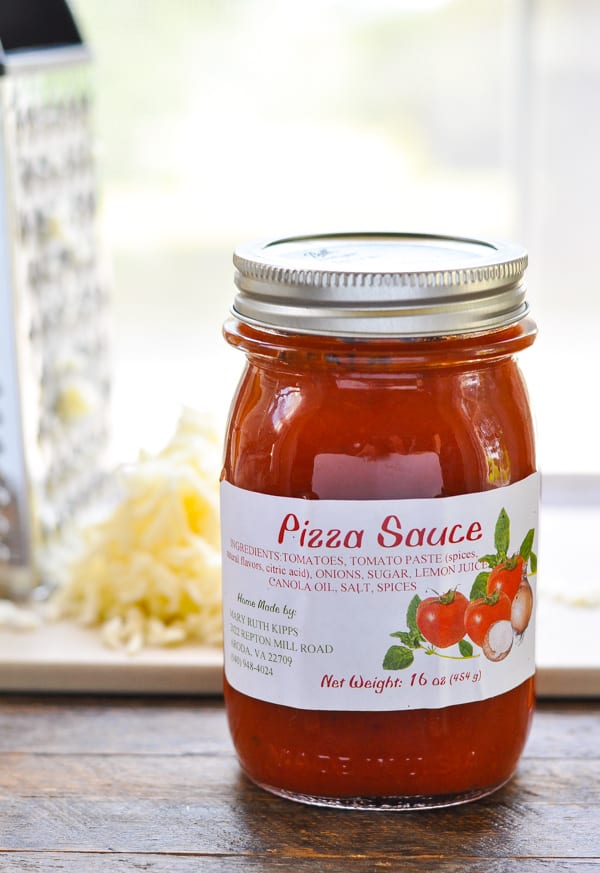
Tips for Making the Best Easy Pizza Dough from Scratch
- Use a really good sauce! I buy this homemade pizza sauce from my neighbor, who makes it with her homegrown tomatoes each summer. You can make your own pizza sauce at home, or you can purchase a high-quality brand at the store.
- For a really crispy crust, preheat the baking sheet or pizza stone in the oven while the oven preheats. Be careful when transferring your pizza to the hot baking sheet!
- Bake at a high temperature. I recommend at least 475 degrees F, but you can go as high as 500 degrees. This helps to simulate the hot ovens that restaurants use, resulting in the best homemade pizza crust.
- Prep the dough on parchment paper. No need to make a mess using cornmeal to prevent the dough from sticking. Instead, you can slide the parchment onto the baking sheet, making it very easy (and clean) to transfer the dough.
- Parbake the Crust. If you plan to add a lot of toppings to your pizza, parbake the crust for 5 minutes before adding the toppings. This will help the crust stay crispy under all of those additional ingredients.
- Brush the crust with olive oil to help it turn crisp and golden brown in the oven.

More pizza recipes that you might enjoy:
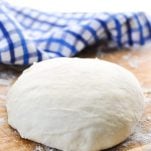
Easy Pizza Dough
Ingredients
- 4 ¼ – 4 ¾ cups bread flour, plus extra for dusting the counter
- 1 envelope (2 ¼ teaspoons) instant (“rapid-rise”) yeast
- 1 ½ teaspoons salt
- 2 tablespoons olive oil, plus extra for greasing bowl and brushing crust
- 1 ¾ cups warm water (about 110-115 degrees F)
Instructions
- In the large bowl of a stand mixer, whisk together flour, yeast and salt. Add the dough hook to the mixer, turn to low speed, and gradually add the oil. Continue mixing on low speed and gradually add the warm water. The dough should come together in a rough ball and pull away from the sides of the bowl. It will be sticky and wet, but the dough shouldn’t stick to the sides of the bowl. If it’s too sticky and wet, gradually add a little bit more flour until the dough comes together.
- Continue kneading with the dough hook for 5 minutes. Transfer dough to a bowl that has been greased with olive oil. Turn dough over to coat in the oil. Cover with plastic wrap and let rise in a warm place until doubled in size, about 1 – 1 ½ hours.
- Turn the dough out onto a lightly floured counter. Cut into three equal pieces and cover with plastic wrap. Working with one piece of dough at a time, shape into a smooth, round ball. Cover again with plastic wrap and let rest for 20-30 minutes.
- Uncover the dough and stretch and shape the dough into a 10-12-inch round on a piece of parchment paper. Use additional flour on your hands and on the dough if it’s sticky.
- Slide the parchment paper and dough onto a baking sheet. Add desired toppings; brush crust with olive oil.
- Bake at 475 degrees F for 14-17 minutes, or until the crust is golden brown and the cheese is melted. Cut into triangles and serve!


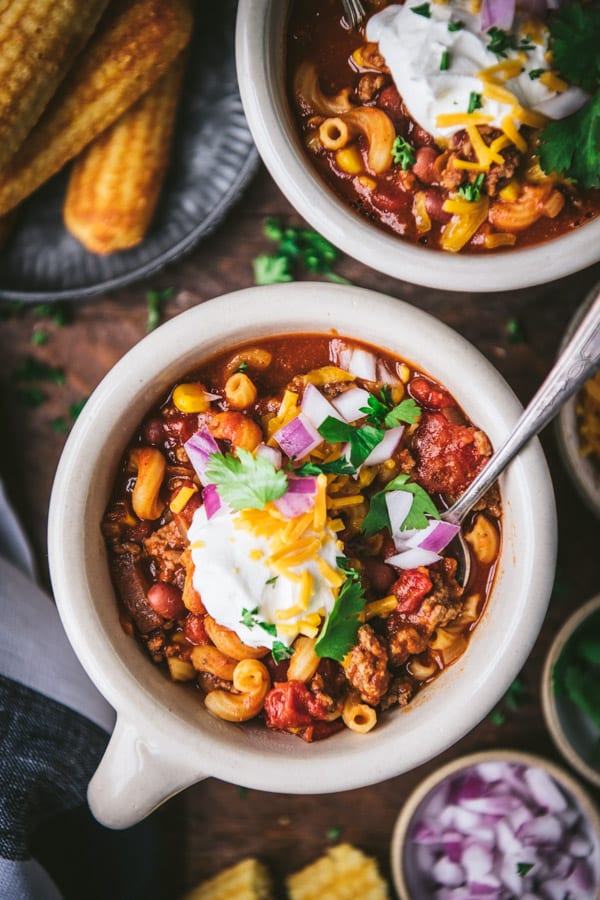










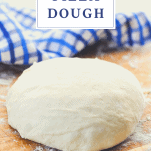

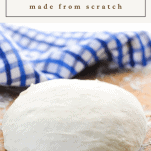

Perfect. Even with Gluten Free 1:1 flour. Thanks very much
Thanks, Pamela! I’m glad to know that it worked with GF flour, too. 🙂
Is there any Beni fit to using OO flour?
Hi, Pat! I’ve never used 00 flour since it’s not readily available near me, so I can’t say how it would compare in this particular recipe. That said, I know that many Italian chefs rely on 00 flour for the best pizza crust. The fine flour is high in protein and low gluten, so it’s sturdy, with high elasticity for kneading, but also delicate enough to prevent a tough or rubbery texture. Since 00 flour is so fine, you might not need as much water. Let us know if you give it a try!
Is bread flour a must? Or can I use regular old flour? Thanks!
Hi, Katie! You can definitely use all-purpose flour. All-purpose flour has between 8 and 11 percent protein, while bread flour contains between 12 and 14 percent protein. I recommend bread flour because the extra protein in bread flour yields a chewier crust. That said, you can substitute with an equal amount of all-purpose flour — it will just yield a softer crust. Hope you enjoy!